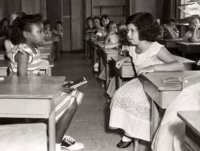Rethinking Conversations on Race Among Educators
Confession: I spent most of my formative years wrestling with the idea of "acting white."
The term "acting white" is often used against children of color who either still struggle with their self-concept or have taken on characteristics in their personalities that may not seem original to their ethnic background. Many of the people who know the present me always say that I don't look like I've ever had an issue with race, or that I handle race well. It's not that I never saw race; it's that I had to learn how to handle it at an early age. Negotiating the different worlds that I occupied, from the hood to the exclusive high school, I quickly learned that the best way to deal with race is to take on the norms and biases that come with it.
I learned how to work with the idea of race through experience, and lots of help from a book every educator ought to have in their bookshelves: Why Are All the Black Kids Sitting Together in the Cafeteria? by Dr. Beverly Daniel Tatum. In this book, she clearly defines some of the words we use freely in our discussions and gives us a framework for how to discuss race, culture and ethnicity in a constructive manner and in layman's terms.
Unfortunately, America still has a hard time working with race in a constructive way. Educators particularly find themselves at the center of the discussion. It's not just because we have the opportunity to speak daily to our students on this subject, but also because of the racial breakdown of teachers in our schools. When 83% of all teachers are white (non-Hispanic) with an ever-increasing student body of color, we can no longer stand by and expect the race discussion to solve itself.
It's a big monster. Students cross lines. Teachers get upset and ignore. Principals avoid at all costs. Here are five tips I've learned about having these discussions.
1. Discomfort is the Starting Point, Not the End Goal
Discussions about big ideas like race, religion and politics necessitate some discomfort. By discomfort, I mean that people who participate in the discussion have a degree of soul-searching and reassessment about their own perceptions and biases. For instance, does one person find that their opinions get listened to more readily than those of certain school colleagues? Do they always sit with people of similar interests, or does it go deeper than that? How often do they interact with people that don't look like them or speak like them? As long as people begin with a clear understanding that the discussion won't start off with warm, fuzzy feelings, then the next few steps become easier.
2. Proceed with the Best Intentions
The power of positive thinking works even in spaces where controversy arises. Despite our various experiences, we have to be willing to listen and not react immediately. The person speaking may say things in error, and usually speaks from exposure or lack thereof. We also have to keep in mind that, when we do get a chance to speak, we can't assume complete ignorance. If someone just doesn't understand an experience, we have to try our best to explain the experience with as much clarity as possible.
3. Be Honest and Inclusive
When it's your turn to speak up, you should come into the conversation with an understanding that whatever you say comes from a place of wanting to learn. Not everyone has the same understandings about race. We also have to keep in mind that those most affected negatively by race inevitably do most of the teaching. We shouldn't take this to mean that they also get to dominate the conversation; if anything, we all need to make sure a true exchange of ideas happens.
4. Facilitation Matters
With any discussion, having a good facilitator matters. Let's be honest: people can get carried away with their opinions. At the center of the discussion, we need to have someone or a collection of people who can set the norms for how the discussion goes. That person does not necessarily require special expertise in matters of race, but they should have a clear sense of how to ask questions, clarify thoughts, rephrase when necessary, and help bring some solutions or understandings to the fore.
5. Solutions Include Confronting Racism Wherever We Can
Having conversations is not enough anymore. Plenty of us have attended consortia on racism and other forms of prejudice, and rarely do the conversations end with some form of resolution or actionable item. In the 21st century, we have to get better at doing the small things that contribute positively to our environments. Things like including more people within our circles, recognizing how we sit during faculty conferences, and addressing how we speak to children who may or may not look like us (and how we teach them to approach others) all go a long way towards deconstructing racism.
Many of the solutions start with us. We can apply some of these tips as needed. While principals should take the lead, sometimes they neither have the tools nor the sense of self to hear these discussions. Some leaders may take personally the fact that a race problem exists in a school, or they might see it as a reflection of the person pointing out the issue. In other environments, an educator may not see the importance of discussing race because they consider themselves color-blind, despite the fact that research has disproven such an idea. (For an in-depth look at color-blind racism, I recommend Racism Without Racists by Eduardo Bonilla-Silva.)
Let's sit down and have a conversation instead of looking for reasons not to. In these times, achievement without social justice is an injustice for all.
